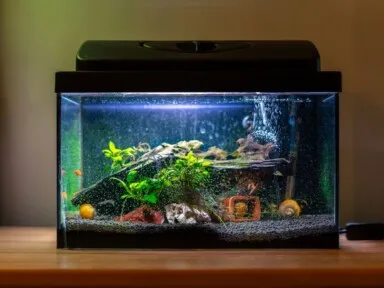While purified water is great for people, using it in your fish tank requires more consideration. From lacking essential minerals to harmful levels of chlorine, not all purified water is suitable for fish — at least not without being treated.
Learn about the different types of purification and understand what’s best for your water and your fish before setting up your aquarium.
In this article:
- Understanding Purified Water
- Suitability of Purified Water for Fish Tanks
- Alternative Water Options for Fish Tanks
- Preparing Purified Water for Aquarium Use
- Fish Species and Water Requirements
- Not All Purified Water Is the Same
- Frequently asked questions
Understanding Purified Water
To find the best filtered water for pets, you first have to understand how water is purified and the types of purified water available.
What is Purified Water?
Purification refers to the process of reducing or removing unwanted materials from water, from heavy metals to microorganisms. Purified water has better odor and taste, has less cloudiness, and is safer to drink.
Types of Purified Water
There are several methods to purify water, including distillation, reverse osmosis, and deionization. Here’s how they work:
- Distilled water: Water is boiled until it turns to gas and then liquid again, removing contaminants, such as lead or bacteria.
- Reverse osmosis water: Pressure pushes the water through a semi-permeable membrane, filtering out heavy metals, PFAs, and other contaminants.
- Deionized water: Water filters through a tank of resin beads that capture ions, removing minerals from the water.
Suitability of Purified Water for Fish Tanks
While purified water is clean, you may need to enhance it before adding it to your fish tank. Here’s a breakdown of the pros and cons of adding purified water to your aquarium.
Pros of Using Purified Water
With purified water, you don’t have to worry about potentially harmful substances lurking in your fish tank. Depending on the purification process, contaminants such as heavy metals, bacteria, viruses, and sediment are removed. Another benefit of using purified water is that you know what’s in it and you can better control and understand its composition.
Cons of Using Purified Water
The main drawback of using purified water in your home aquarium is that the purification process eliminates minerals essential for your fish’s health. Fortunately, you can re-mineralize, dechlorinate, and balance the pH of purified water before pouring it into your fish tank, although this can add extra steps to your care routine.
Alternative Water Options for Fish Tanks
Purified water is not the only option for filling up your fish tank. Here’s what you need to know about spring, well, and tap water in your aquarium.
- Spring water: Spring water works well for fish tanks as it’s typically clean and mineral-rich, although its exact contents can vary by brand and water source.
- Well water: While some well water can be clean enough to use in a fish tank, this water source varies greatly, so it’s important to conduct water testing at home.
- Tap water: Tap water can be safe to fill a fish tank, but you may need to soften or dechlorinate it first.
Preparing Purified Water for Aquarium Use
While purified water may not be ready to use in your fish tank as is, there are a few ways you can prepare it to be more suitable for your fish.
Re-Mineralizing the Water
Minerals, like potassium, magnesium, and calcium, are important for fish and aquarium plants to thrive. Luckily, there are several ways to re-mineralize your purified water, including mixing in a mineral additive from the pet store. An even more budget-friendly way to add minerals to your fish tank is to mix in a little bit of tap water, assuming it doesn’t contain any chlorine.
Balancing pH Levels
Fish need to live within a certain pH range to stay healthy, and the required pH levels depend on the species. Most purified water has a pH of 7, but you can buy pH solutions to increase or decrease the pH for your fish’s needs. Regularly using pH test strips can help you monitor stability and ensure it stays within a healthy range for your fish.
Dechlorinating the Water
One of the benefits of using purified water is that it doesn’t contain chlorine, which can harm your fish. If you are using a water source that contains chlorine, like tap water, add a water conditioner from the pet store to safely dechlorinate it before use.
Fish Species and Water Requirements
Just as the characteristics of purified water can vary, so can the needs of fish. While freshwater fish thrive in spring water, saltwater fish tanks are better suited to distilled or reverse osmosis (RO) water. Different species of fish may require different pH levels as well. For example, goldfish need a 6.5 to 7.5 pH, but clownfish require a pH of 7.8 to 8.4.
Not All Purified Water Is the Same
The term “purified water” encompasses a variety of purification processes, from reverse osmosis to distillation. While some types of purified water are safe for your fish, pre-treatment is often required. Whether re-mineralizing or dechlorinating, regularly testing your water quality helps keep your fish healthy and thriving.
FAQs
Bottled spring water and clean tap water are best for fish tank use. Purified water can also be used if minerals are re-added.
You don’t have to use distilled water in a fish tank. In fact, purified water types such as reverse osmosis (RO) water may be better for your fish depending on its needs.
Although purified water is great for human consumption, some purification methods make it less suitable for goldfish. For example, if the water has undergone reverse osmosis, it may lack essential minerals, like calcium, and needs to be re-mineralized.
Bottled spring water is fine to use in aquariums, but avoid using distilled bottled water unless you re-mineralize it first.




